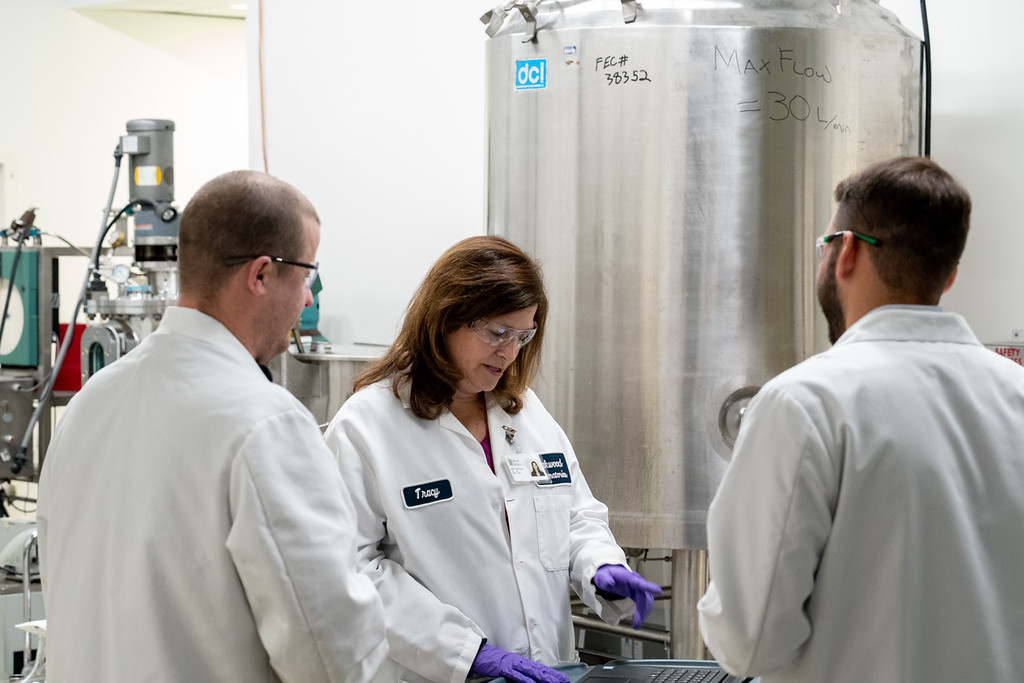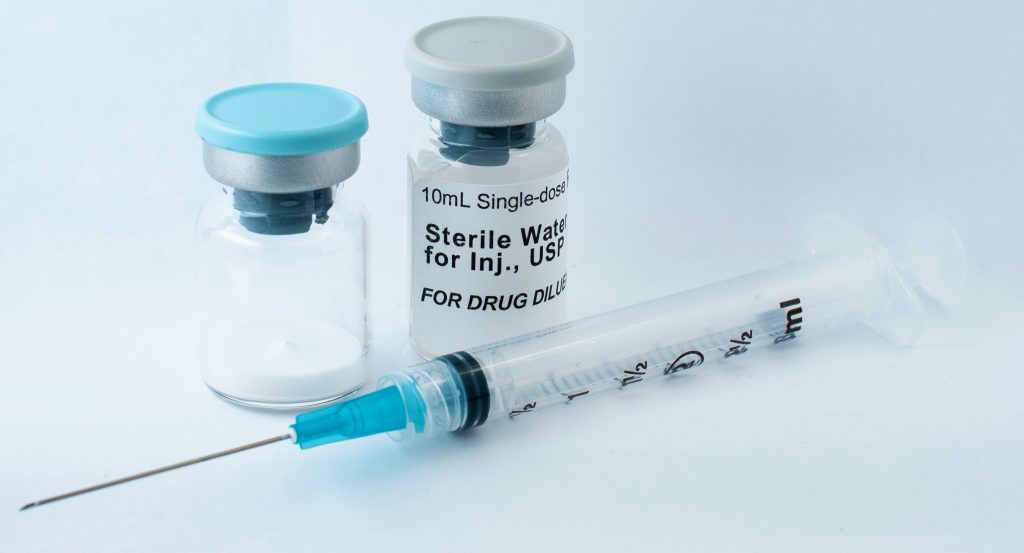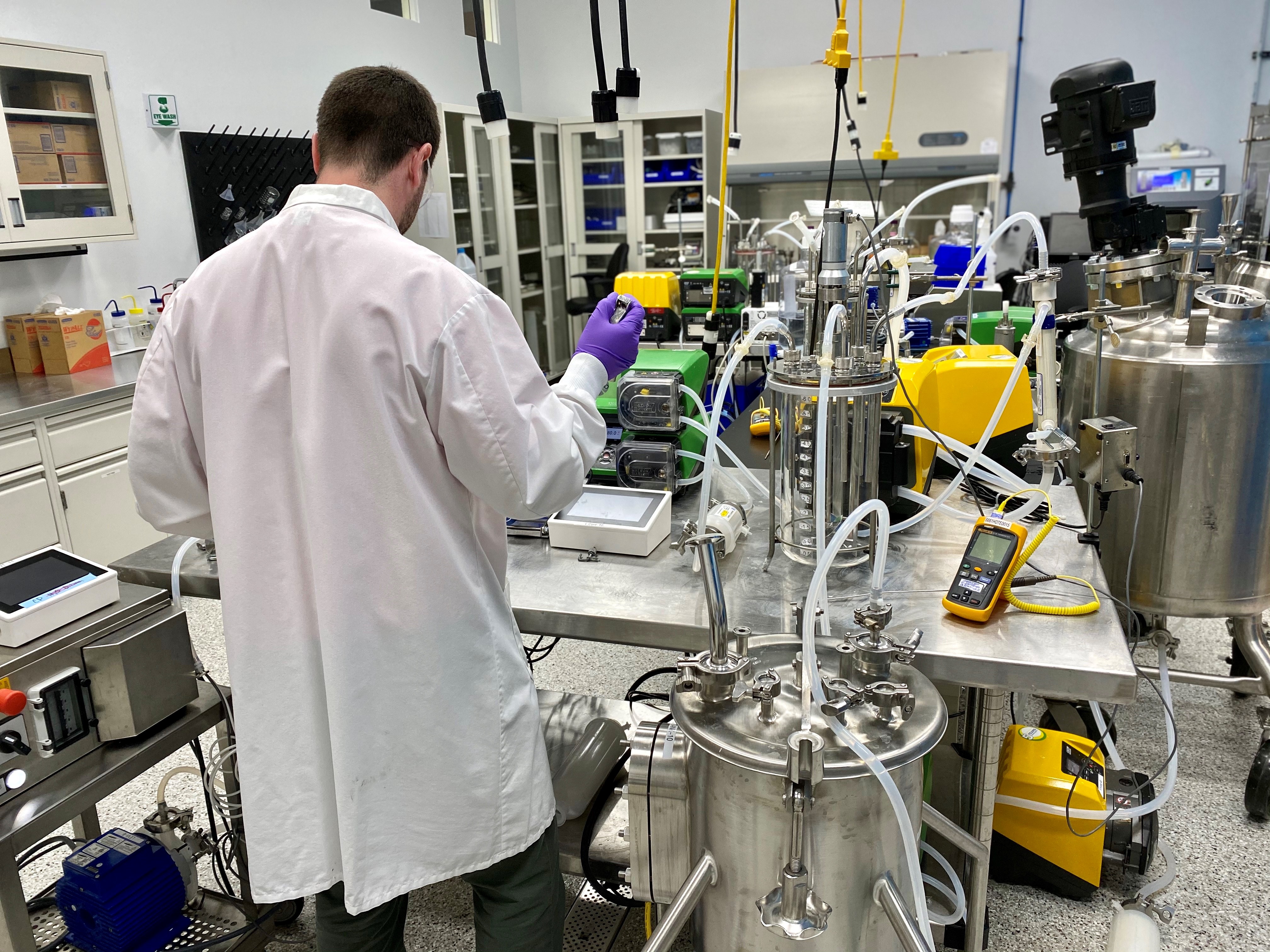Category Archives: Education

At Oakwood Labs, we’re proud to contribute to the development of cancer pharmaceuticals through our continuous work manufacturing long-acting injectables (LAIs). That’s why we’ve compiled an informational guide showcasing our ongoing work in the healthcare field, as well as the numerous benefits of LAIs for oncology treatment.
Advantages of Long-Acting Injectables to Treat Cancer
There are numerous advantages to the use of LAIs as pharmaceuticals to treat cancer. To start, Bruton tyrosine kinase (BTK) inhibitors are established standards of care in multiple B-cell malignancies including chronic lymphocytic leukemia, mantle cell lymphoma, and Waldenstrom macroglobulinemia. LAI formulations of BTK inhibitors offer certain advantages in terms of pharmacokinetics (PK) and patient adherence. For example, ibrutinib (Imbruvica) has a very short half-life of 4-6 hours. Hence, relatively large doses of the oral form are required to target plasma levels within the therapeutic range.
The PK profile is marked by large peaks and valleys, sometimes exceeding the therapeutic level, and sometimes falling below. The PK profile of the LAI formulation is much “smoother,” having no significant peaks and valleys. Also, the oral bioavailability of ibrutinib is only 3% and varies among patients. The LAI formulation, meanwhile, is 100% bioavailable and therefore can be administered at much lower per-day doses.
These factors above could reduce side effects caused by off-target receptor interactions, while maintaining efficacy, and result in fewer cases in which the medication needs to be discontinued. The LAI formulations of two weeks and one month ensure patient adherence for these periods, possibly enhancing efficacy in clinical practice.
Similar benefits may be possible with other immunomodulatory cancer pharmaceuticals, such as the thalidomide analog pomalidomide (Pomalyst), indicated for multiple myeloma. The recommended dose for multiple myeloma is 4 mg per day taken orally on days 1 through 21 of repeated 28-day cycles. The half-life is approximately 7.5 hours and oral bioavailability is estimated to be approximately 75%. The LAI formulation reduces the peaks and valleys of drug exposure, enables a reduction in the total amount of drug administered, reduces the frequency of doses, possibly reduces side effects, and ensures patient adherence.
Additional Benefits to Highlight
Along with administration approaches and the long-term effects on the body, LAIs as oncology pharmaceuticals possess several key advantages for the patient, including:
- Reduced treatment burden
- Increased patient compliance
- Sustained stable hormone suppression
How Oakwood Labs Is Contributing to Cancer Drug Development
Alongside working with external partners who have been seeking out LAIs for their own initiatives, our team is also currently in the process of creating internal programs that utilize our very own microparticle technology. The goal of these internal initiatives is to convert an existing product into an LAI formulation to extend the duration of drug release to what is currently on the market, achieving patient compliance and ease of use.
More specifically, Oakwood Labs has used its internal technology to progress its formulations that are focused on treating mantle cell lymphoma, small lymphocytic lymphoma, chronic lymphocytic leukemia, and multiple myeloma with release durations ranging anywhere between two and four weeks. Our LAI oncology drug development has led to significant benefits for patients, such as:
- Reducing the amount of drug administered to the patient
- Decreasing the number of doses needing to be injected
- Diminishing more adverse reactions and side effects from dosages

Partnership Opportunities
At this point in the cancer drug development process, our team is actively seeking an external partner to help further develop our internal program. Key responsibilities in this area include funding ongoing development activities as well as phases one through three of clinical trials and registration/commercialization efforts.
If you’re interested in learning more about this opportunity, please contact our team directly, as we would be happy to provide additional details or answer any questions you may have.
FAQs About Oncology Pharmaceuticals, Development, and More
Can you provide me a brief history of oncology pharmaceutical development and its breakthroughs?
Though it is estimated that the preliminary study and treatment of cancer was initially recorded as early as 520 BCE when Persian queen Atossa was treated for a breast tumor, modern-day pharmaceuticals for treating cancer did not surface until relatively recently. Just some of the pivotal findings in this scientific journey include:
- The 1840s – Physician Rudolf Virchow is well-known for his observation of cancer cells during this time, in which he defined their key characteristics. This led to the future of cancer treatment protocols by the start of the 20th
- 1895 – Once German physicist Wilhelm Conrad Röntgen first correctly identified the waves of radiation that we all now know as X-rays, this equipment was then used in radiotherapy cancer treatment shortly thereafter.
- The 1940s – Based on the discovery that nitrogen mustard contains anticancer properties during World War II, researchers were able to develop various cytotoxic drugs to directly target dividing cancer cells, which later led to today’s chemotherapy practices.
Can you tell me more about the work Oakwood Labs does to develop LAIs?
Oakwood Labs performs LAI development through our technology platform Chroniject™, and some characteristics of products we have made with this system including the following:
- The duration of release is one week to one year
- LAIs are easily syringable with 18- to 23-gauge needles
- Products are reconstituted immediately with sterile water
- LAIs are filled aseptically and terminally sterilized if feasible
- Products have proven content uniformity and good stability characteristics
- LAIs are free of foreign particulate matter
Additionally, Chroniject™ is microsphere-based and has biodegradable polymers such as PLA, PLGA, and other polymers with demonstrated low toxicity and sourced from multiple suppliers. Plus, the finished dosage form typically consists of a lyophilized vial containing microspheres, a suspending agent, and other excipients.
What are the current barriers to an LAI entering this particular space?
The barrier to entry is that LAI formulations are extremely difficult to develop and require a high degree of technical expertise. Once developed, you then need to scale up the process to be able to manufacture in an aseptic GMP facility. The Oakwood Labs team can work with you to overcome key challenges.
What are some common trends in the development of drugs to treat cancer?
As healthcare professionals and pharmaceutical developers continue to produce different types of drugs for treating cancer, numerous trends have emerged from their discoveries, such as:
- Targeted drugs for treatment
- Immunotherapy
- Monoclonal antibodies
- Small molecule-targeted agents
- CRISPR
- Biomaterials, such as chitosan oligosaccharide (COS)
These recent practices have significantly advanced the oncology field, leading to longer, happier, and healthier lives for patients undergoing treatment.
Contact Oakwood Labs for More Information
If you have any additional questions about the oncology drug development process, or if you’re looking to get in touch with us regarding a potential partnership opportunity, please contact our team today. We look forward to assisting you.
Different health conditions and disorders can require a range of tactics for successful treatment, and mental and emotional issues patients face are no exception. Conditions such as depression, schizophrenia, bipolar disorder, and more require reliable medications paired with other forms of therapy to elicit the best results, which is where the team at Oakwood Labs comes in.
We’re adept at developing long-acting injectables for treating major depressive disorder and other conditions, and we’ve successfully manufactured and scaled up formulations for diverse clients. Read on to learn about our depression pharmaceutical development and other key services.
A Brief History of Depression Pharmaceutical Development
The age of modern antidepressant drugs began in the early 1950s when researchers who were attempting to cure tuberculosis instead noticed that two of the chemicals found in their test batch compounds – isoniazid and iproniazid – improved the mental states of test subjects.
Research continued until the initial phase of depression pharmaceutical development was under way, leading to tricyclic antidepressants and monoamine oxidase inhibitors. Though a step forward for the greater cause, side effects these drugs produced were troublesome, leading to more research and development being necessary in the field. Despite some of their associated issues, drugs of these type are still prescribed in some cases.
The second phase of research focused on key neurotransmitters and divided medication into the categories of selective serotonin reuptake inhibitors and norepinephrine reuptake inhibitors. SSRIs tended to be much safer than the previous drugs on the market, though they were not always as effective, leading to the development of SNRIs, which covered a larger selection of neurotransmitters.
All of the drugs that fell under these classifications traditionally were administered through the means of oral medication, though that is changing in the modern era. The viability of utilizing injectables for treating depression is becoming more recognized, paving the way for new treatments and advancements.
Our Process for Developing Long-Acting Injectables to Treat Major Depressive Disorder
At Oakwood Labs, when it comes to creating long-acting injectables for depression, schizophrenia, bipolar disorder, and other conditions, we stand out as being one of the few independent companies that can develop these products from concept to FDA approval.
Our facilities utilize proven technology that has shown scalability from 5-10 g starting batch size to 32 kg commercial batch size, and we also have the ability to manufacture our products aseptically within our own GMP facility.
When it comes to injectables for treating depression, Oakwood Labs partners with organizations to work on external projects, and we also have an extensive internal development project pipeline within the CNS space. We are actively looking to partner with organizations, so if you have a project in mind be sure to contact us.
How We Overcome Difficulties
One barrier for using long-acting injectables to treat major depressive disorder is the difficulty in formulating and manufacturing these drugs aseptically. In order to develop and commercialize a product, you need specialized drug delivery technology and an effective process, such as the one used at Oakwood Labs.
Our process allows for a customized release profile for every product, and the ability to scale up that formulation for a commercial batch size.
Benefits of Shifting from Oral Medications to Long-Acting Injectables to Treat Depression
One of the primary advantages to making this change is patient compliance, as patients who suffer from schizophrenia, depression, bipolar disorder and other conditions sometimes do not want to take a prescribed drug, or they forget to. That is why many schizophrenia drugs, for instance, are now available in both oral and long-acting injectable forms.
Other major benefits of using long-acting injectables include:
- Reducing the number of required injections
- Being able to target specific anatomical areas
- Helping to prevent drug abuse
All of these aspects can help contribute to better care, assisting facilities and doctors in providing the best for their patients.
Our Services Beyond Depression Pharmaceutical Development
When you choose to partner with Oakwood Labs, you’ll be working with a global leader in sustained-release drug delivery who can supply a range of services. Some of our offerings beyond injectables for treating depression include:
- Microsphere formulation development
- Formulation optimization and scale-up
- Analytical method development
- GMP aseptic manufacturing
- Contract manufacturing
Please review specifics about each service on their respective pages, and get in touch with us if you are interested in beginning a project.
Contact Oakwood Labs Today
If you’re looking to partner with an experienced team to produce long-acting injectables for major depressive disorder and other conditions, Oakwood Labs is your resource. Get in touch with us and we’ll help you determine a plan of action.
Quick Differences Between the Three
- Contract Research Organizations (CROs) primarily handle research and regulatory activities, such as clinical trial management and compliance, supporting companies in the early stages of drug development.
- Contract Manufacturing Organizations (CMOs) focus on large-scale drug production and manufacturing, leveraging advanced technologies and expertise to ensure both quality and regulatory standards are met.
- Contract Development and Manufacturing Organizations (CDMOs) offer comprehensive, end-to-end services that cover both drug development and manufacturing; partnering with a CDMO can accelerate timelines, reduce costs, and assure full regulatory compliance throughout the drug’s lifecycle.
- The choice between a CRO, CMO, or CDMO depends on your company’s specific needs. CROs are ideal for research support, CMOs for manufacturing, and CDMOs for complete process outsourcing, including development and production.
When developing and manufacturing a new drug, the list of requirements can get extensive. With the needs for drug discovery, development research, review, and production, there are a lot of moving parts to ensure that a product is safe for patients once it hits the market.
Due to this, assistance for the different phases of pharmaceutical drug development is often sought out, and these support companies come in the form of CDMOs, CROs, and CMOs, organizations that serve the pharmaceutical and biotechnology industries. Learn more about the differences between these organizations in our post so you can determine which will be the most beneficial during your pharmaceutical development process.
CRO vs. CMO vs. CDMO
Let’s explore the distinctions between the three types of organizations that can aid you in your pharmaceutical processes.
Contract Research Organization
A Contract Research Organization, or a CRO, is a destination for research, including clinical trial management, preclinical research, data management, regulatory affairs, and post-marketing surveillance. These organizations focus mostly on research and development services, including clinical trials and regulatory compliance. This means they are involved mostly in the early stages of drug development and play a major role in the overall research and regulatory aspects of drug development.
CROs largely support pharmaceutical companies in research and regulations. Outsourcing to a CRO allows the pharmaceutical company to focus on building other areas of the business and prioritizing other tasks.
Contract Manufacturing Organization
A Contract Manufacturing Organization, or a CMO, specializes in the production of pharmaceuticals and all things related to manufacturing. CMOs are adept at handling large-scale production once the drug has been developed. Their services are beneficial because they utilize cutting-edge technology and have skilled employees who bring expertise to the development process.
Working with a CMO also ensures that the final product is compliant with both quality and regulatory standards, which allows the pharmaceutical company to focus on other things like drug discovery and marketing.
Contract Development Manufacturing Organization
A Contract Development and Manufacturing Organization, or a CDMO, offers a full range of services, from drug development through manufacturing. With operations in place for process development, scale-up, clinical trials, material production, and manufacturing, a CDMO is your end-to-end partner.
Because they are involved throughout the ensure lifecycle of drug development and manufacturing, CDMO facilities help pharmaceutical companies to reduce costs, accelerate time to market, and ensure regulatory standards are adhered to. Consult a CDMO to bridge the gap between development and manufacturing and achieve the most comprehensive solution.
Which Partner Is Best for You?
When deciding which organization to work with, be sure to analyze your company’s needs and challenges. If you are seeking a partner for clinical research support, a CRO is your answer. When you need manufacturing help, a CMO is going to be an ideal match. And if you want to outsource the entire process and ensure everything goes smoothly, a full-service CDMO is going to provide comprehensive and integrated development, support, and manufacturing. When you are looking for a reliable CMO or CDMO partner, Oakwood Labs is here to help.
At Oakwood Labs, we offer CDMO and CMO services for your convenience, and our team has over 25 years of experience with developing and manufacturing injectables for the pharmaceutical industry. We specialize in sustained-release and targeted-release injectables for long-term therapeutic relief. Along with this, our facility follows GMP aseptic manufacturing processes to provide FDA-approved pharmaceuticals to our clients.
Learn More About Our Abilities as Your Pharmaceutical Partner
Please contact us today to learn more about everything we can provide as your CMO or CDMO partner. We look forward to assisting you.
Quick Insights on Subcutaneous Drug Delivery
- Subcutaneous (subQ) drug delivery injects medication beneath the skin for fast absorption and quick effects, making it ideal for emergencies and some chronic treatments.
- It offers better bioavailability and more consistent absorption than oral drugs, with less pain and more injection site options than intramuscular delivery.
- Sustained-release formulations provide prolonged drug delivery, reducing dosing frequency and improving patient compliance through technologies like microspheres and implantable devices.
- SubQ delivery is patient-friendly, cutting treatment times and lowering the risk of vein damage compared to intravenous methods, enabling easier self-administration and better comfort.
There are many routes of drug delivery, including oral, intravenous, intramuscular, transdermal, inhalation, and subcutaneous. The choice of route will depend on the desired onset of action, the medication’s properties, and patient preferences.
Subcutaneous, or subQ, drugs are delivered below the skin into the layer of tissue beneath the dermis and epidermis. They are typically administered using a needle, which allows the drug to be absorbed into the bloodstream and distributed throughout the body. Read on to learn about key facets of subcutaneous drug delivery and development and how the Oakwood Labs team can assist you with the process.
Understanding the Benefits of Subcutaneous Delivery of Drugs
The subcutaneous delivery of drugs works to balance effectiveness, convenience, and patient comfort while providing therapeutic relief. The location of an injection is usually preferred on the thigh, stomach (around the belly button), or the upper outer arm. The injection device often depends on the dose, ergonomic design for ease of use, and other factors, but can include syringes with attached needles, prefilled syringes, autoinjectors, and pen injectors. Drugs that are administered subcutaneously include insulin for diabetes, growth hormones, anticoagulants, vaccines, and certain types of chemotherapy drugs.
The benefits of subcutaneous drug delivery include:
- Fast absorption – Depending on the drug being administered, it is possible for subcutaneous drugs to absorb rapidly into the bloodstream because they bypass the digestive system. This leads to a quicker onset of action, making them ideal for anything that requires quick effects or emergency treatments.
- User-friendly application – Did you know that some EpiPens use subcutaneous delivery? When not administered through an intramuscular route, EpiPens can use subcutaneous drug delivery in the upper thigh to treat allergic reactions, which means they are able to be used by patients of almost any age.
- Improved bioavailability – Certain drugs have poor oral bioavailability due to degradation in the digestive tract or metabolism in the liver. Subcutaneous delivery of a drug improves its bioavailability because it releases the drug directly into the circulation of the system.
- Reduced variability in absorption – Oral medications can be impacted by food intake and gastrointestinal factors. Subcutaneous drug delivery provides more consistent and reliable absorption, which offers more consistent results.
- Versatility – Subcutaneous delivery is ideal because it is typically less painful and offers a larger range of possible injection sites when compared to intramuscular injections.
- Sustained-release design – There are specific drugs that can be delivered subcutaneously over an extended period of time. This results in more stable drug levels in the bloodstream, which improves patient compliance by removing the need for frequent dosing.
Using Sustained-Release Subcutaneous Drug Delivery
Using sustained-release subcutaneous drugs provides a controlled and prolonged release of medicine into the bloodstream. This results in consistent therapeutic effects for patients and reduces the need for frequent visits. Additionally, it reduces any side effects because the formulations are created to consistently deliver the drug, therefore minimizing peak drug concentrations. When starting the development of sustained-release, subcutaneous-delivery drugs, there are many different factors to consider, including drug solubility, release kinetics, biodegradability, and compatibility with the injection method.
Once it’s time to formulate the subcutaneous drug that uses sustained-release technology, it is essential to consider the matrix systems, microsphere or nanoparticle formulations, and implantable devices. If you need assistance with your subcutaneous drug development, the dedicated team at Oakwood Labs is ready to get to work on your project.
Choose Oakwood Labs for Developing Subcutaneous-Delivery Drugs
Since 1997, Oakwood Labs has been operating a fully compliant, aseptic cGMP manufacturing facility that is designed to manufacture sustained-release injectable pharmaceutical products, and we are adept at subcutaneous drug development.
Our team is committed to creating pharmaceutical products that provide enhanced therapeutic benefits to patients and returns to our pharmaceutical partners, using our Chroniject™, a patented polymer-based injectable microsphere system for drug delivery. Be sure to use our team’s expertise and our cutting-edge facility for your next project.
Contact Us About Subcutaneous Drug Development
For more information on our abilities in subcutaneous drug development, please contact us today. We’re ready to assist you.
Related Blog Posts

Learn about the background of intra-articular injections, the means of treatment, and what it’s like to work with Oakwood Labs to develop them for your operations.
The History of Intra-Articular Injections
Intra-articular injections were the product of a few different methods of pre-existing treatments and have evolved alongside technology and discoveries within the medical space to become what they are today. Part of the origin for intra-articular injections derived from joint aspiration, where healthcare professionals would remove fluid from the joint space and assess the fluid for any inflammatory conditions or infections.
Another milestone that helped in the development of intra-articular injections was the introduction of corticosteroids in injections. These substances have powerful anti-inflammatory properties and were found to be effective in the treatment of joint inflammation. Therefore, it made sense to test them in intra-articular injections, which proved to be a success.
Additionally, advancements in imaging techniques like ultrasounds and fluoroscopy helped increase the accuracy and precision of intra-articular injections, as these tools can help guide the needle during injection.
As ongoing research and innovation occurred, more discoveries about intra-articular injections were made. These advancements continued to encourage the production of the best treatments possible, and clinical guidelines and standardizations ensured proper administration, patient safety, and optimal outcomes.
Today, intra-articular injections are used widely in rheumatology, orthopedics, and sports medicine to provide relief to patients. Typically, these patients have osteoarthritis, rheumatoid arthritis, gout, tendinitis, bursitis, joint effusion, or post-operative swelling.
Medications Utilized in Intra-Articular Injections
Depending on their needs and previous medical history, candidates for intra-articular injections are typically treated with the following:
- Corticosteroids – As mentioned above, corticosteroids like cortisone can be extremely therapeutic for patients who have joint pain. Corticosteroids are very powerful anti-inflammatory medications that alleviate joint pain by reducing swelling and inflammation.
- Hyaluronic acid – Hyaluronic acid is a substance that is naturally found in joint fluid and can be injected to provide lubrication and cushioning in joints. It is often used to treat conditions like osteoarthritis.
- Platelet-rich plasma – PRP is used to promote healing and reduce pain and inflammation in patients. It is derived from the patient’s blood and is rich in both platelets and growth factors.
Let Our Team Help
If you are looking for a partner who can assist with manufacturing intra-articular injections, Oakwood Labs is ready to step in. We use a patented technology called ChronijectTM to help you treat patients through parenteral drug administration, the umbrella term that refers to delivering medications and other therapeutic benefits through routes other than the digestive tract. Intra-articular delivery is one of the ways to do this.
The Oakwood Labs team operates in an FDA-approved, aseptic facility and is committed to adhering to Good Manufacturing Practices to ensure product safety and quality. From material sourcing and formulation to sterilization, filling, packing, and beyond, the Oakwood Labs team is there with you every step of the way in the manufacturing process. We have been manufacturing pharmaceutical treatments since 1997, and look forward to continuing to innovate into the future.
Contact Oakwood Labs for Intra-Articular Injection Manufacturing
If you are ready to provide therapeutic relief to patients with joint pain through intra-articular injection manufacturing, be sure to contact us today.
We look forward to working with you on your next project.
Animal pharmaceuticals are treatments that are designed to prevent, diagnose, or treat disease in animals to promote overall well-being. This goal applies to a variety of animals, including livestock, poultry, and even wildlife.
The world of animal health pharmaceutical development has also played a significant role in the fast-growing and evolving world of pet pharmaceuticals. Read on to learn about all of these aspects and how Oakwood Labs can partner with your facility for effective pharmaceutical development.
Our Process for Animal Health Drug Development
The demand for animal health pharmaceuticals is rising due to population growth, urbanization, changes in dietary habits, increased awareness of animal welfare, and more. To keep up with this demand, the industry continues to shift via research, new technology, and regulations that address the evolving needs of animals.
Discover the advantages of animal health pharmaceutical development:
- Improved animal health and welfare – Veterinary pharmaceuticals are a way to provide effective treatments for infections and chronic conditions. Just like humans, pets and livestock need treatments when they fall ill or have an ongoing condition, and these treatments make symptoms much more tolerable for the animal and its owner.
- Disease prevention and control – Injectables and other preventative medicines help control the spread of infectious diseases among animals, which reduces the risk of outbreak and transmission to other animals and even humans in some cases.
- Companion animal care – Pharmaceuticals for pets address varied health concerns, including pain management, behavioral issues, and chronic diseases. Having medicines that treat these problems gives owners a way to provide optimal care for their pet, fostering stronger bonds.
- Food safety and security – Pharmaceuticals are critical for maintaining the health of livestock and poultry, which leads to safer and higher-quality animal-derived food products. This results in a better food supply chain by reducing the risk of foodborne illnesses.
FAQs About Animal Health Pharmaceutical Development
To help you get a better understanding of animal health pharmaceutical development, we listed some FAQs that might clear up some confusion on the subject.
What is the general process for animal health drug development?
Animal health pharmaceutical development follows a similar process to that of drug manufacturing for humans. The stages include research and discovery, preclinical testing, regulatory approval, clinical trials, manufacturing, quality control, and post-market surveillance. The FDA oversees the approval and safety of animal health pharmaceuticals, ensuring that they meet the standards for efficacy.
What are some recent developments in animal health pharmaceuticals?
Discoveries in the area of animal health pharmaceutical development are being made constantly. Some of the more notable ones made recently include the development of novel drug technologies, the discovery of new treatment modalities, and the use of genomics and biotechnology to develop customized medicine for animals.
How do long-acting injectables benefit animal health drug development?
Long-acting injectables offer sustained therapeutic effects through a single injection, which is convenient for both animals and their caregivers. This method of administration minimizes stress for animals and improves treatment adherence, which leads to better outcomes for a variety of health conditions.
Work with Oakwood Labs for Animal Health Drug Development
At Oakwood Labs, we have a full-service cGMP manufacturing facility that hosts a range of contract manufacturing services. We produce commercial products for use by both humans and animals, and our batch sizes range from 1,000 to 20,000 vials per batch. In our GMP manufacturing facility, we are able to accomplish the following:
- In-house QC microbiology and QC chemistry
- Raw material dispensing and weighing
- Non-aseptic formulation
- Equipment preparation and staging
- Compact and portable equipment train
- Aseptic formulation
- Aseptic filling
- Aseptic lyophilization
- Vial capping
- Inspecting, labeling, and packaging
- Shipping and receiving
In addition to these capabilities, we also bring more than 20 years of experience to your project. We would love to be your partner in animal health drug development.
Contact Us Today About Animal Health Pharmaceutical Drug Development
When you are ready to get started with animal health pharmaceutical drug development, we are ready to assist.
Be sure to contact us today with any questions you might have.
Oakwood Labs is a global leader in sustained-release drug delivery. Our facility provides feasibility studies, analytical development, scale-up capabilities, GMP clinical trial material, GMP contract manufacturing, and sterile fill-finish.
Sterile fill-finish is the final leg of the pharmaceutical manufacturing process, where a substance is filled into vials, ampoules, or other containers deemed appropriate. After the substance is put into containers, it is ready to be sent out for distribution. Learn more about our capabilities for this part of the process below.
The Process for Fill-Finish Pharmaceuticals
There are a variety of reasons that sterile fill-finish is essential in the manufacturing of long-acting injectables. Patient safety is at the top of the list, however, as the approach ensures that the product is free from microbial contamination.
What the Process Entails
When you begin the sterile fill-finish step, you are almost at the end of the drug manufacturing process. However, this is a critical point of the overall manufacturing process because it needs to be done correctly to ensure that your drug is safe for patients. At this point, you’ll want to request help from a fill-finish CDMO who can oversee the process properly.
Some of the steps that will be completed will include:
- Filling – In the filling process, the drug is placed into the final product containers under controlled and sterile conditions. Finish and fill services must be completed in a sterile environment to prevent contamination. For this reason, these services are performed in a cleanroom that has controlled air quality, temperature, and humidity. Additionally, it is important to ensure that sterile filling techniques are also applied to equipment and packaging.
- Container closure – It is important to select the appropriate container closer that is going to maintain the sterility and stability of the drug. Whether this is a vial, syringe, ampoule, or something else, the team you work with will help find the right solution for your application.
- Quality control – In the process of fill-finish for pharmaceuticals, rigorous quality control is practiced to ensure that the product meets regulations. Not only is the product tested throughout the process, but it also undergoes environmental monitoring and final product review to ensure that it is sterile and potent, and that it meets all other criteria that is required.
- Labeling and packaging – Once the product is filled, the finished item is labeled and packaged according to regulations and any requirements provided by outside sources.
- Regulation compliance check – It is important for aseptic, CDMO facilities to adhere to regulatory guidelines like Good Manufacturing Practice (GMP). This helps to ensure safety, efficacy, and quality, completing the final steps of the finish and fill process.
When you choose to work with a fill-finish CDMO, you can also receive different batch sizes to meet your project’s needs. From small-scale clinical trials to large-scale commercial production, our processes can be adapted to your specifications.
Let Oakwood Labs Be Your Fill-Finish CDMO
Oakwood Labs operates a fully compliant aseptic GMP facility. Our FDA-approved facility is headquartered near Cleveland, Ohio and centers on the development and manufacturing of sustained-release injectables for the pharmaceutical industry. We focus on creating pharmaceutical products that provide therapeutic benefits to our patients and excellent returns for our partners.
Whether you need assistance with fill-finish pharmaceutical services or something else, we are here to help. Other services we provide include:
- Formulation and analytical development activities
- Accelerated and long-term stability studies
- Scale-up, validation, or engineering batches
- Complete method transfer and validation
- Batch record and protocol development
Consult Our Finish and Fill Services Today!
If you are in need of pharmaceutical manufacturing, partner with Oakwood Labs to receive reliable and efficient services.
Contact us today to learn how you can achieve a sterile fill-finish with our CDMO.
Best known for their versatile role in a vast array of chemical applications, organic solvents play a crucial role in numerous sectors, including the medical industry.
To gain a better understanding of how these solvents can contribute to pharmaceutical practices and manufacturing techniques for drug delivery, review our complete guide for more information.
An Overview of Organic Solvents
As industry experts are aware, organic solvents are solvents that contain carbon atoms capable of either dispersing or dissolving one or more substances. Due to their chemical makeup, these solvents can be utilized in a variety of industries, such as textiles, cleaning, agriculture, and pharmaceuticals.
Additionally, common characteristics and properties of suitable organic solvents include the following:
- High volatility
- Acid-based properties
- Low boiling point
- Suitable density
As opposed to some inorganic solvents, organic solvents can also be described as combustible and extremely flammable. That’s why we advise that those looking to work with organic solvents in long-acting injectables, or processes such as spinning and dyeing textiles, ensure that they are handling these carbon-based solvents with the utmost care.
The Role of Organic Solvents in Long-Acting Injectables
Organic solvents in pharmaceuticals, such as long-lasting injectables, can contribute to an expansive array of roles throughout the drug delivery process, such as the following:
- Dissolving drugs at high concentrations – Organic solvents can be utilized to dissolve drugs, such as biologics, that otherwise have a higher concentration and a lower aqueous solubility. That way, long-acting injectables can be administered at the appropriate viscosity and form drug depots under the skin’s surface.
- Forming drug depots – Drug depots, or depot injections, are longer-duration drugs that result in a slow absorption into the bloodstream. Though organic solvents can contribute to the formation of these drug depots, the administration of the drug into your muscle is best when using a depot.
- Determining the rate of release – Once the drug depot has formed, organic solvents decelerate the rate of their delivery, resulting in a more gradual, sustainable release and absorption of the medication over time.
A Look at Organic Solvents in Pharmaceuticals: Their Industry Uses and Beyond
Along with their inherent contribution to the production of long-lasting injectables, organic solvents in pharmaceuticals play many key roles in the total industry. Beyond mainly being utilized as reaction media, organic solvents are used in the following processes:
- The purification of synthesis products
- Excipients, such as coloring agents, preservatives, and fillers
- The bioavailability of orally administered protein-active sites
- Semiempirical models of meditated solubility
- Antisolvent crystallization techniques in pharmaceutics
Additionally, organic solvents can even be used in water-based cleaning solutions. This is because they are capable of penetrating oily soil deposits while also dissolving in water.
FAQs About Organic Solvents, Their Capabilities, and More
What are the most common organic solvents used in pharmaceutical manufacturing?
The most common applications when working with organic solvents in pharmaceuticals include the following:
- Acetone
- Dimethylformamide
- Diethyl ether
- Benzene
- Isopropanol
- Ethanol
What safety precautions should be taken when working with organic solvents in pharmaceuticals?
As stated previously, organic solvents can be extremely flammable and volatile, so handling them with care is essential. With that in mind, here are some stringent safety regulations you should abide by during the manufacturing process:
- Gloves and safety glasses should be worn when handling the materials
- A fume-hood is required when pouring out organic solvents
- Spill kits and eyewash stations should be readily available in the workspace
- Flammable liquids, such as bleach, peroxides, and acids, should be stored away from organic solvents
Can organic solvents be reused or recycled?
Yes, organic solvents can be recycled easily and reused in syntheses. This includes collected solvents that are separated by distillation and have different boiling points.
Contact Oakwood Labs for More Information
As your trusted resource for sustained-release injectables and other services, Oakwood Labs is well-equipped with the necessary tools to satisfy your application needs.
For more information about organic solvents in pharmaceuticals, long-acting injectables, and more, please reach out to our team today. We look forward to assisting you.
Long-acting injectables are favored in the medical field due to their effectiveness and convenience, as their injection methodology allows for the gradual release of medication into the bloodstream. In post-operative care, the alleviation of pain is vital not only for recovery, but for the comfort of the patient. With the help of long-acting injectable drugs for post-surgical pain management, patients can experience a more effective recovery.
The History of Long-Acting Injectables
Long-acting injectable drugs were first introduced as a treatment for people with chronic schizophrenia. These long-acting injectable antipsychotic drugs were created as an effort to solve the issue of poor adherence to oral medications. Some notable points in the history of long-acting injectables include the following:
- 1950s – 1970s – Long-acting injectables were created to help manage conditions such as schizophrenia. In 1952, chlorpromazine (CPZ) was developed in Paris, offering an effectiveness greater than that of older drugs on the market. Then in 1966, thanks to G.R. Daniels, a medical director at the time, the first long-acting injectable was created. This first injectable was AP fluphenazine enanthate, with fluphenazine decanoate being created just eighteen months later.
- 1980s – 1990s – During this time, long-acting injectables for second-generation antipsychotics were introduced. Between 1988 and 1992, Risperidone was first developed by Janssen-Cilag. Its purpose was to treat behavior issues in children and adolescents.
- 2000s – present – Long-acting injectables have come a long way since their creation. With their medication methodology, they can provide better adherence to timelines, facilitate proper dosing, and free patients from having to take oral medications every day. With continuing research on long-acting injectables, we are seeing uses in areas such as contraception, chronic and acute pain, antiretroviral therapy, and more.
The Role of Long-Acting Injectables for Post-Surgical Pain Management
A key factor of post-surgical work is minimizing patient pain, giving them the time they need to heal. With the use of extended-release drugs for post-surgical pain management, doctors are better able to effectively manage pain for their patients and promote an expedited recovery process.
Types of Injectables Used for Post-Surgery
NSAIDs, or nonsteroidal anti-inflammatory drugs, are medications that reduce fever, pain, and inflammation. Looking at postoperative care, NSAIDs help in mitigating pain, minimizing the reliance on opioids, and fostering a healing environment. You may be familiar with some over-the-counter NSAIDs such as ibuprofen or aspirin.
NSAIDs are known to prevent blood from clotting, which can definitely be beneficial in post-surgery situations. In cases such as orthopedic procedures that involve prolonged immobility, there is an increased risk of blood clot formation. NSAIDs help prevent that blood clotting, specifically in the veins.
Some common NSAIDs that have been used as long-acting injectables for post-surgery pain management include:
- Toradol (Ketorolac) – This NSAID is used to relive pain and is commonly available in injection or tablet form. The injections work about thirty minutes after administration and the effects can last up to six hours. Often prescribed for post-surgery pain, it typically is distributed as a one-time injection. However, some people may receive a shot every six hours. This will depend on factors such as body weight, age, drug interactions, and others.
- Diclofenac sodium – This medication is another NSAID used to treat adults with mild to moderate pain. It can be used for osteoarthritis, low back pain and for post-operative patients. Similar to Toradol, the effects may start to work immediately after the injection.
- Caldor – This ibuprofen injection works by reducing fever and treating pain in the body. It helps manage pain as an adjunct to opioid analgesics.
- Ketoprofen – Ketoprofen can help with acute and chronic pain, both for the traumatic and rheumatic origin. Additionally, it can help alleviate postoperative pain, specifically in the orthopedic field. While ketoprofen is offered as an injectable, that is not the intended use for humans. There is an oral tablet for humans, only available with a doctor’s prescription. The injectable form is actually intended for animals, such as horses. In horses, it’s used for musculoskeletal pain or inflammation, abdominal pain, and other inflammatory conditions. It can also be used effectively for cattle, goats, sheep, and pigs.
The Capabilities of Oakwood Labs
At Oakwood Labs, we are a leading developer of sustained-release pharmaceuticals and have over 20 years of experience in drug encapsulation. We are here to offer support throughout the development of different types of long-acting injectables.
Our facilities can provide the following to help you achieve your project goals:
- GMP manufacturing (commercial and aseptic)
- Pre-formulation development
- Phase I, II, and III clinical trial manufacturing
- Scaling formulation
- ICH compliant stability tests
- Feasibility studies
- Toxicology batch manufacturing
Contact Us to Learn More
With our history of compliance and commitment to quality, we continue to be a leader in injectable pharmaceutical development. If you’re wanting to learn more about injectable development or our other capabilities, contact us today.
Knee pain is a common issue for adults because it is caused by general stress from normal daily activities. In fact, around 25% of U.S. adults experience knee pain, and many of them require treatment to make day-to-day activities easier.
Long-acting injectables are able to target specific anatomical areas like eyes, ears, knees, and other spots to relieve pain and reduce systemic exposure. This means they are capable of providing a means of comfort for patients experiencing problems like osteoarthritis, rheumatoid arthritis, bursitis, or tendonitis. Learn more about the benefits of extended-release drugs for knee pain and how you can help patients by manufacturing them.
Benefits of Using Extended-Release Drugs for Knee Pain
Extended-release drugs and long-acting injectables for knee pain are designed to release the active ingredient over time. These medications encourage the maintenance of the therapeutic levels in the body for an extended time period and provide prolonged pain relief. The outcome of prolonged pain relief is less frequent dosages and happier patients.
Other benefits of using these types of medication include:
- Reduced side effects – Extended-release drugs encourage lower overall doses when compared to the immediate-release competition. This can lead to fewer side effects, as the patient will be exposed to a lower peak concentration of the drug.
- Improved patient adherence – Since these types of drugs require less frequent doses, patients are more likely to adhere to their prescribed regimen. This can lead to better pain management outcomes, making them the go-to choice for more patients.
- Minimized fluctuations in pain levels – When patients are given immediate-release formulations they may experience highs and lows from the drug concentration that leave them with fluctuations in the extremity of their knee pain. Using extended-release medications for knee pain limits this issue by providing a consistent and controlled release.
Types of Extended-Release Drugs for Knee Pain
There are currently two main types of extended-release injectable drugs for knee pain. The type that is administered will depend on the patient’s problem, pre-existing health conditions, and more.
Corticosteroid Injections
Corticosteroid injections reduce pain and inflammation in the knee joint, thanks to their powerful anti-inflammatory agents. These synthetic drugs mimic the effects of natural hormones produced by adrenal glands. The relief is often found quickly, with many patients experiencing reduced knee pain in just a few days. The relief from these steroid injections should last around three to four months, depending on the patient and the severity of their condition.
A prominent example of a corticosteroid long-acting injectable for knee pain is inserting Triamcinolone LAI in the knee. Another common type is ZILRETTA®.
Hyaluronic Acid Injections
Another type of long-acting injectable drug for knee pain is hyaluronic acid injections. Known for their ability to replenish knee lining and reduce friction on the joints, hyaluronic acid injections are an extremely effective treatment for those fighting osteoarthritis. These injections also protect the cartilage and bone from further damage, relieving pain effectively. While they may not have the longevity of a typical long-acting injectable drug for knee pain, they will provide patient relief for between two and six months.
Hyaluronic knee injections currently on the market include Durolane, Euflexxa, Hyalgan, Monovisc, and more.
Using Best Practices When Manufacturing Long-Acting Injectables for Knee Pain
Adhering to best practices when producing long-acting injectable drugs for knee pain is essential, and it’s something the team at Oakwood Labs is committed to. Doing so assures your patients that the solution was created using rigorous processes and that the medication is safe.
Let’s discuss some of the best practices for creating extended-release drugs for knee pain and how Oakwood Labs can provide the support you’re looking for.
- Conduct clinical research and development – The process starts with conducting pre-clinical studies to assess feasibility, safety, and efficacy. Then, it is time to study the population to create the intended patient demographic, as well as execute clinical trials to ensure that the solution is relevant to the problem and population.
- Create optimal formula – The next step is to research and develop a formulation that will provide sustained and effective pain relief without complications or introducing new side effects. Be sure to check this over time and ensure that the extended-release drug for knee pain will continue to provide the most benefits to the patient.
- Determine dosing and administration – Based on clinical research results, you will want to determine an appropriate dosage and administration schedule. Then, create clear and concise instructions for proper administration for patient safety and reduced risk.
- Assess safety – Once you develop the proper instructions for administering the long-acting injectable for knee pain, it is important to conduct comprehensive safety assessments that define adverse effects, drug interactions, and any risks. Then, be sure to monitor unexpected side effects during post-marketing surveillance.
- Provide education and training – Collect comprehensive educational materials that healthcare professionals and patients can look at to ensure the best understanding of the long-acting injectable for knee pain as well as any side effects.
- Adhere to ethics – Ethics are a priority in pharmaceutical manufacturing, covering everything from reporting results to ensuring equal access. Be sure to adhere to ethical standards in all aspects of development.
- Choose a GMP manufacturer – Oakwood Labs operates in an FDA-approved cGMP manufacturing facility that is capable of conducting Phase I, II, and III clinical materials, delivering commercial products, and more. We also have decades of industry experience, making us the ideal destination for manufacturing long-acting injectables for knee pain. As your partner, we can offer short lead times, robust systems, CMC development capabilities, and so much more.
Contact Us to Learn More
If you are interested in manufacturing extended-release drugs for knee pain, Oakwood Labs would be happy to partner with you.









